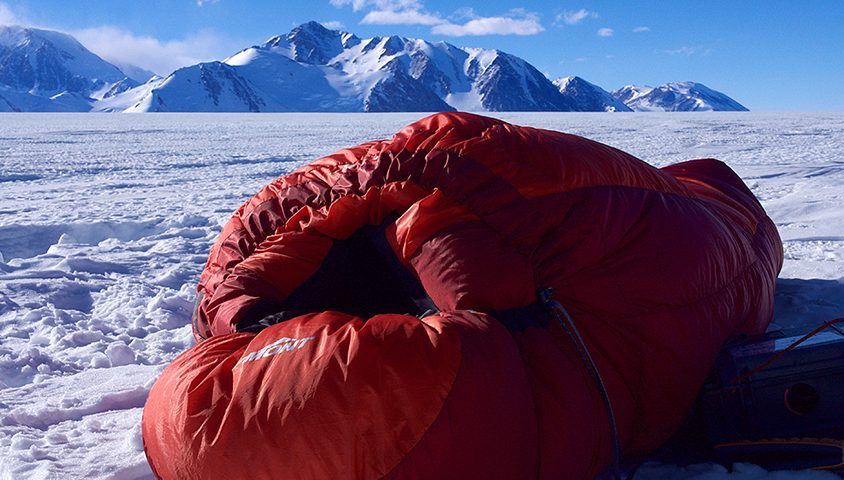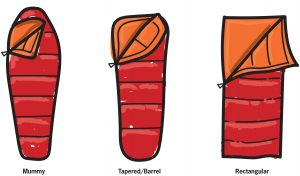Back in my university days, I took a holiday with friends to southern France and Andorra. We were hiking in the mountains in Andorra and decided to spend a night in one of the many free mountain huts across the country. More than 20 years later, I still remember this night as being one of the coldest and most uncomfortable nights of my life. It probably didn’t actually get that cold, perhaps only -5C. However, there were five of us and we had two lightweight, super-cheap sleeping bags between us. Here we were, four 20-something guys and one girl, all huddling, shivering and clattering on the wooden bunk-bench of the hut, trying to share the bags as blankets.
Sleeping cold sucks. Being unprepared in a cold climate is not only very uncomfortable, but in some circumstances, can be quite dangerous. Owning a cold weather sleeping bag and being able to stay warm will be a foundational piece of kit for any cold weather overnight activity.
A good sleeping bag is most likely to be one of your more expensive pieces of outdoor gear. Below, we’ve provided a comprehensive guide of all things to consider when buying a cold weather sleeping bag.
Temperature Ratings
Perhaps the most important consideration when choosing any sleeping bag is the temperature rating of the bag. Too warm and you’ll be sweating it out during the night. Too cold and you’ll be awake all night. In extreme cases, too cold, and the risk of hypothermia or worse.
Similar to tent ratings, sleeping bags will often use the below ratings:
- One-season: The coolest bag on the spectrum, generally used for late spring/summer camping. These bags usually do away with hoods and can often be completely unzipped.
- Two-season: More versatile that one-season bags, these are usually best for Spring/Summer and some autumn camping.
- Three-season: These are the most common and versatile of bags on the market. Generally these bags are pretty good all year around, including on warmer winter nights. These bags usually provide a range of features, including different shapes, sizes and fill types. A three-season bag is generally a good choice for most Australian winter conditions.
- Four-season: These bags are starting to get serious and are designed for winter and autumn. The challenge with these bags is outside of winter, you’ll often find yourself unzipping the bag to stay cool during the warmer months.
- Five-season: Heavier, more durable and often with water-repellent outer fabrics, these are the bags for serious cold and snow conditions.
Since 2005, most European countries and increasingly many other countries have adopted a new standardised way to measure the thermal properties of a sleeping bag. This standard moves away from the above ‘season’ rating and recommended retailer temperature guides and instead moves to an independent standardised way of testing a bag. The European EN13537 (like an ISO standard) measure provides a standard temperature result for normal sleepers.
EN13537 Temperature Ratings
- Comfort — the lower limit temperature at which a standard woman can expect to sleep comfortably in a relaxed position.
- Lower Limit — the lowest temperature at which a standard man can sleep for eight hours in a curled position without waking.
- Extreme — the minimum temperature at which a standard woman can remain for six hours without risk of death from hypothermia (though frostbite is still possible). This is a point of danger that can lead to death.
(A fourth Upper Limit rating is also very occasionally provided.)
So what do I pick?
The recommended temperature rating of a bag is the temperature rating at which a normal person is likely to stay asleep. For many people, the you get closer to that temperature, the more likely you wake up. As it starts to get colder than the temperature rating, then you are almost certainly going to wake up and be cold. Generally speaking, you should look to purchase a bag that is warmer than the expected ambient temperature. If you wake up warm you can undo the sleeping bag. If you wake up cold, there’s not much you can do.
I’m a woman, not a man!
Men will generally sleep a few degrees warmer than women. So when the temperature drops, women will be more likely to feel the cold sooner. Also, few of us are ‘standard’. Height and body fat and other factors will also impact how people feel at various temperatures.
NOTE: Just because a bag does not use the EN13537, does not mean the recommended temperature ratings are not valid or that the bag is any less effective. It does mean that the ratings provided are from the manufacturer themselves. You may want to understand what in-house testing they have completed.
Down or Synthetic?
Choosing between down or synthetic is an age-old debate as to why to choose one of the over. While both versions have their pros and cons, generally speaking down fill will last longer than synthetic fill, pack smaller, and have a better warmth-to-weight ratio (ie lighter for the same warmth). Synthetic bags are generally cheaper and perform better when wet (down loses its thermal qualities when wet and is unlikely to remain completely impervious to moisture even with a water-repellent protection). While the weight to thermal properties of synthetic fill is continuously getting better, good quality down still offers the best weight-to-warmth ratio available. If you are going to be in cold, dry conditions, down is your better option, whereas synthetic is a better choice for cold wet conditions. For a more detailed explanation on Down see following page.
Fit and Shape
The shape of bag is designed to provide a balance between comfort and performance. A larger bag with more room internally will give you more freedom and space internally and likely be a little more comfortable. However, this added freedom is at the expense of thermal properties with the greater movement of air reducing the bag’s thermal efficiency.
Bags will traditionally come in three shapes:
Mummy – the most thermal efficient bag. Wider at the shoulders and tapering down at the feet. These bags are generally the lightest, pack down the most and are the warmest of the bag shapes. However, some people find the tight fit restrictive and claustrophobic and its certainly worth trying this shape out before buying, especially if you move around a lot while asleep.
Tapered/Barrel – while still tapering at the feet, this shape is not quite as pronounced as the mummy shape and offers a medium between the mummy and rectangular bags.
Rectangular – the bags are closer in width at both shoulders and feet and allow much more movement internally. Generally heavier and not able to pack down as much, these bags tend not to be used for cold weather conditions. Usually these bags do not include a hood and often allow you to completely unzip the bag
Remember also that bags will often come in a Standard (or Regular), Long, or Extra-long length. Excess space at your feet will create more air-movement and colder feet.
Storing your sleeping bag
You might be tempted to keep your bag neatly tucked away in its stuff sack. However, over an extended period of time this will reduce the lifespan of the bag. When you get home, unzip your bag and air it out ensuring it is completely dry. The best way to store your bag is loosely hanging from a hanger, otherwise in large pillowcase or cotton bag. Many bags will come with both a stuff sack and larger storage bag.
Liner, Mattress and Tents
In addition to your bag, you should also consider a sleeping bag liner and the type of mattress you use. While a liner is likely to increase the temperature efficiency of you bag by a few degrees and also make cleaning your bag easier, a mattress will not only keep you insulated from the cold of the ground but will also provide a much more comfortable sleep.
Finally, the tent in which you find yourself sleeping may have a significant impact on the ambient temperature of the surrounding air. 1-2 season tents are designed to be airy and allow good air flow, whereas 3-4 season tents are not.
Features of a sleeping bag
Shell and inner materials — What and how is the external and internal fabric of the bag made? Many bags will feature a waterproof and/or breathable outer shell, including a DWR (durable water repellent) coated shell to prevent condensation, snow and rain from soaking through. Many manufacturers have developed specific fabrics, unique to their own bags and it is worth understanding what benefits these fabrics provide (strength, durability, weight, breathability, water resistance, down-proof construction).
Baffles — Compartments within the sleeping bag designed to prevent the insulation from moving around too much, causing cold spots. Some bags allow you adjust the fill for your own preferred comfort.
Hood — Essential for cold weather. 80 percent of body heat is lost through your head, so a good hood that can be drawn tight is important for cold weather.
Zipper — Does the bag completely open or only partially open. Are the zippers one or two directional? Is there a left or right option? What size are the zippers? Trying to fiddle with a zipper during an icy cold night can be extremely frustrating. Do the zippers have anti-snagging protection or their own baffle to prevent heat loss?
Foot box — Designed to keep hold and keep your feet warm. Consider the construction, specific thermal qualities and weather any additional durable or waterproof materials have been used.
Pockets — Can you store anything inside your bag?
Hang hooks — Being able to easily hang your bag at home is always handy.
Stuff sack and storage sack — Many manufacturers will provide both. The stuff sack is all about getting the bag as small as possible, while the storage sack should be big and airy to allow plenty of circulation while in storage.
There are a lot of things to consider when buying a sleeping bag and each bag really is designed for a specific reason. You should think about the conditions in which you will most often use your bag, the likely high and low temperatures you are going to find yourself in, the importance of weight and stuff size, and of course your available budget. It is not uncommon for many outdoor enthusiasts to own a couple of different bags, each to be used under certain conditions.
Read the full guide along with 12 sleeping bag reviews in Wild 160. Subscribe today.



